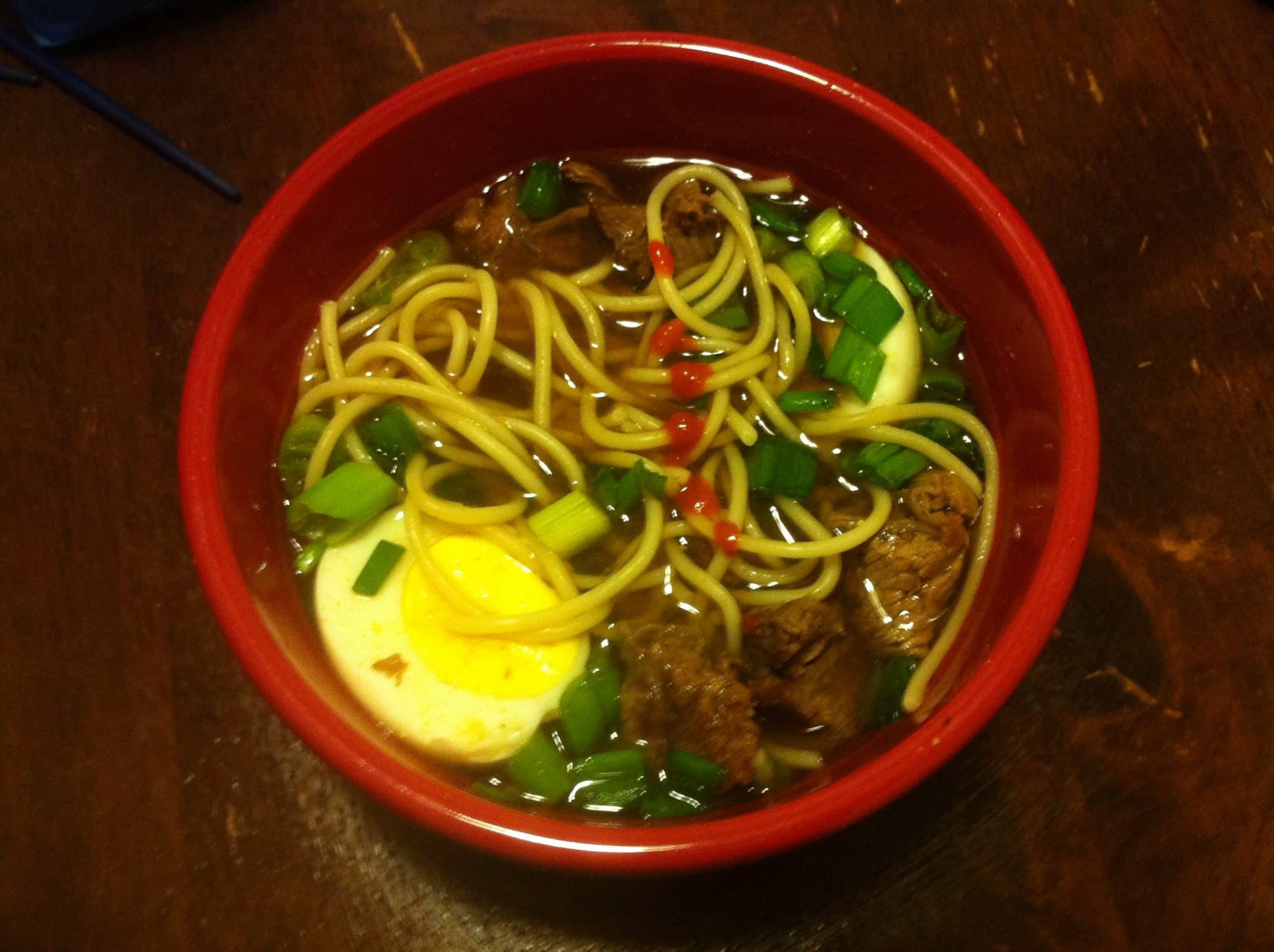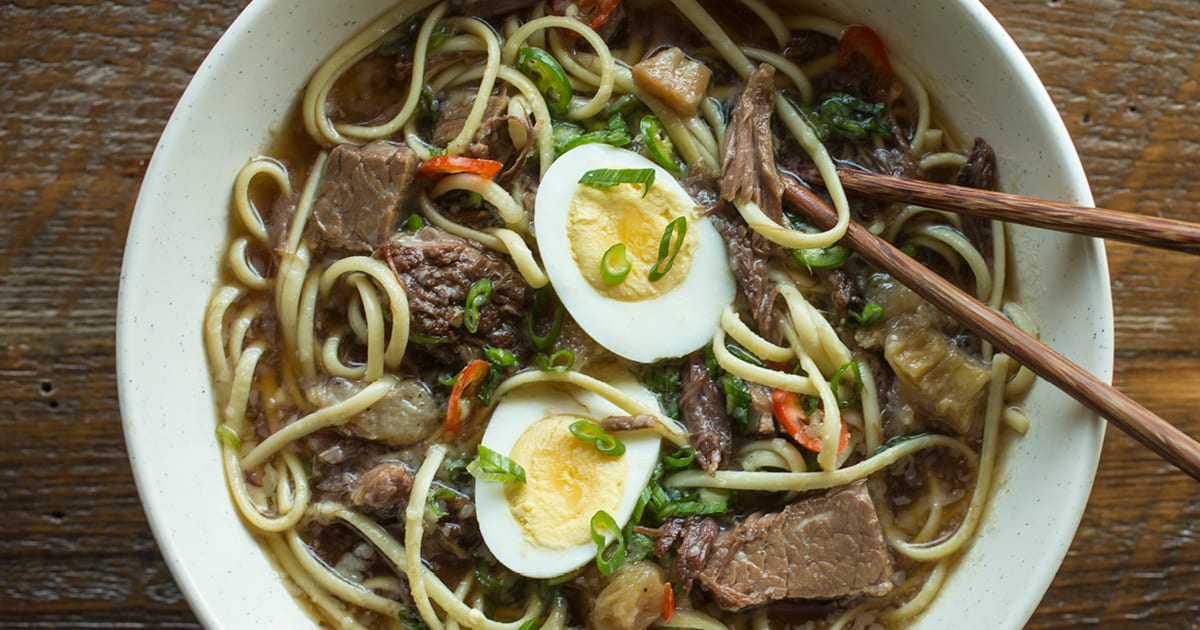Miss Linda’s yakamein recipe takes center stage in this culinary expedition, inviting readers to embark on a flavorful adventure. This dish, steeped in tradition and brimming with originality, promises an unforgettable gastronomic experience.
From its humble beginnings to its widespread popularity, Miss Linda’s yakamein has captivated taste buds and woven itself into the cultural fabric of communities. Join us as we delve into the intricacies of this beloved dish, exploring its ingredients, cooking methods, variations, and cultural significance.
Ingredients: Miss Linda’s Yakamein Recipe

Miss Linda’s yakamein recipe calls for a variety of ingredients that come together to create a flavorful and satisfying dish. These ingredients include:
- Chicken stock: 8 cups of chicken stock provide the base for the yakamein’s broth.
- Pork neck bones: 2 pounds of pork neck bones add depth of flavor to the broth.
- Smoked sausage: 1 pound of smoked sausage, sliced, adds a smoky and savory element.
- Chicken thighs: 2 pounds of chicken thighs, cooked and shredded, provide a tender and juicy protein.
- Shrimp: 1 pound of shrimp, peeled and deveined, adds a seafood element to the dish.
- Yakamein noodles: 1 pound of yakamein noodles, cooked according to package directions, provide the base of the dish.
- Green onions: 1 cup of green onions, sliced, add freshness and color.
- Celery: 1 cup of celery, sliced, adds a crunchy texture and additional flavor.
- Bell peppers: 1 cup of bell peppers, diced, add sweetness and color.
- Soy sauce: 1/4 cup of soy sauce adds a salty and savory flavor.
- Oyster sauce: 1/4 cup of oyster sauce adds a rich and umami flavor.
- Fish sauce: 1 tablespoon of fish sauce adds a salty and pungent flavor.
- Black pepper: 1 teaspoon of black pepper adds a touch of spice.
Cooking s

Preparing Miss Linda’s yakamein is a culinary adventure that combines the flavors of the sea and the land. Follow these precise s to create this delectable dish:
Preparing the Broth
- In a large pot, brown the pork ribs and chicken wings over medium heat.
- Add the onions, celery, and bell peppers and sauté until softened.
- Pour in the chicken broth and bring to a boil.
- Reduce heat to low and simmer for at least 2 hours, or up to 4 hours for a richer flavor.
- Strain the broth through a fine-mesh sieve into a clean pot.
Making the Yakamein Noodles
- In a large bowl, combine the flour, salt, and water. Knead until a smooth and elastic dough forms.
- Divide the dough into small balls and roll them out into thin, long noodles.
- Cut the noodles into desired lengths.
Assembling the Yakamein
- Bring the strained broth back to a boil.
- Add the yakamein noodles and cook until al dente.
- Add the shrimp, crab, and vegetables and cook until heated through.
- Season with salt and pepper to taste.
- Serve the yakamein hot, topped with green onions and sesame seeds.
Variations and Adaptations
Miss Linda’s yakamein recipe is a versatile dish that can be adapted to suit various tastes and preferences. Here are some common variations and adaptations:
Vegetarian Yakamein
- Omit the pork or seafood and substitute with tofu or tempeh.
- Add extra vegetables such as carrots, celery, and green beans.
Seafood Yakamein
- Replace the pork with a variety of seafood, such as shrimp, crab, or fish.
- Add a seafood broth to enhance the flavor.
Spicy Yakamein, Miss linda’s yakamein recipe
- Add chili peppers or Sriracha sauce to the broth for a spicy kick.
- Use a spicier sausage or bacon.
Creamy Yakamein
- Add a splash of heavy cream or coconut milk to the broth for a richer, creamier texture.
- Top with grated Parmesan cheese.
Cultural Significance
Miss Linda’s yakamein recipe holds immense cultural significance, deeply rooted in the culinary traditions of New Orleans and the surrounding Gulf Coast region. Its origins can be traced back to the vibrant melting pot of cultures that shaped the city, including African, Creole, and Vietnamese influences.
Yakamein emerged as a beloved dish in African American and Vietnamese communities, reflecting the shared experiences and cultural exchange that occurred in New Orleans. The dish became a staple at family gatherings, church functions, and community events, symbolizing unity and a sense of belonging.
Historical Significance
Miss Linda’s yakamein recipe gained prominence in the 1970s, when she began selling her homemade yakamein at a local restaurant. The popularity of her dish quickly spread, attracting a diverse clientele who appreciated its unique flavors and comforting qualities. Yakamein became a symbol of New Orleans’ rich culinary heritage, showcasing the city’s ability to blend different cultures and create something truly special.
Social Impact
Beyond its culinary significance, Miss Linda’s yakamein recipe has had a profound social impact. It has fostered a sense of community and cultural pride, particularly among African Americans and Vietnamese Americans in New Orleans. The dish has been featured in numerous publications and television shows, further solidifying its status as a cultural icon.
Nutritional Value
Miss Linda’s yakamein is a hearty and flavorful dish that offers a range of essential nutrients. This nutritious soup provides a balance of carbohydrates, protein, and healthy fats, making it a satisfying and nourishing meal.
A single serving of yakamein (approximately 1 cup) contains approximately 350 calories, making it a moderate-calorie option. The macronutrient breakdown is as follows:
- Carbohydrates: 45 grams (55% of total calories)
- Protein: 20 grams (25% of total calories)
- Fat: 15 grams (20% of total calories)
Yakamein is also a good source of vitamins and minerals, including:
- Vitamin A: 10% of the Daily Value (DV)
- Vitamin C: 15% of the DV
- Iron: 10% of the DV
- Calcium: 15% of the DV
Potential Health Benefits
Consuming yakamein in moderation can offer several potential health benefits:
- Provides sustained energy due to its high carbohydrate content.
- Supports muscle growth and repair due to its protein content.
- Promotes satiety and helps control appetite due to its fiber content.
- Boosts the immune system due to its vitamin C content.
- Strengthens bones and teeth due to its calcium content.
Considerations
While yakamein is generally a healthy dish, it is important to note the following considerations:
- Sodium content: Yakamein can be high in sodium, especially if additional salt is added during preparation. Individuals with high blood pressure or heart conditions should consume yakamein in moderation.
- Fat content: The fat content in yakamein primarily comes from the pork belly and oil used in cooking. Those concerned about their fat intake should opt for leaner cuts of meat and reduce the amount of oil used.
- Individual dietary needs: As with any food, it is essential to consider individual dietary needs and preferences when consuming yakamein. Those with allergies or specific dietary restrictions should consult with a healthcare professional before consuming this dish.
Presentation and Serving Suggestions
Miss Linda’s yakamein is traditionally presented in a large bowl, adorned with vibrant colors and textures. The noodles are arranged in a generous portion, forming the base of the dish. Atop the noodles, a colorful medley of toppings is artfully placed, including succulent pork, plump shrimp, tender chicken, and an assortment of fresh vegetables. The broth, a rich and flavorful liquid, is poured over the noodles and toppings, completing the presentation.
To enhance the visual appeal of yakamein, consider using colorful ingredients. For instance, instead of plain noodles, opt for spinach or beetroot noodles, adding a vibrant green or pink hue to the dish. Additionally, garnish the yakamein with freshly chopped herbs, such as cilantro, scallions, or basil, providing a vibrant contrast and a refreshing aroma.
Side Dishes and Accompaniments
Yakamein pairs exceptionally well with a variety of side dishes and accompaniments that complement its bold flavors. A simple green salad with a light vinaigrette dressing can provide a refreshing balance to the richness of the yakamein. Fried wontons or spring rolls offer a crispy and savory contrast, adding an extra layer of texture to the meal. For those seeking a spicy kick, a side of pickled jalapeños or sriracha sauce can elevate the heat level of the dish.
Recipe Comparisons
Miss Linda’s yakamein recipe shares similarities with other popular yakamein recipes in terms of its core ingredients and cooking techniques. The use of wheat noodles, shrimp, pork, and vegetables is common across many variations. The broth is typically made with a combination of chicken and pork stock, and the dish is often seasoned with soy sauce, fish sauce, and garlic.
Variations and Adaptations
Variations in yakamein recipes can be found in the specific ingredients used, the proportions of ingredients, and the cooking methods. Some recipes may include additional ingredients such as crab, squid, or mushrooms, while others may use different types of noodles, such as egg noodles or rice noodles. The cooking techniques can also vary, with some recipes calling for the broth to be simmered for several hours, while others use a faster cooking method.
Authenticity and Popularity
The question of which yakamein recipe is most authentic or widely enjoyed is subjective and depends on personal preferences and regional variations. However, Miss Linda’s yakamein recipe is considered by many to be a classic and authentic representation of the dish. It has been featured in numerous publications and cooking shows, and it has received positive reviews from food critics and home cooks alike.
Recipe Optimization

Miss Linda’s yakamein recipe provides a solid foundation for a flavorful and satisfying dish. However, with a few adjustments, we can optimize its flavor, texture, and presentation to create an exceptional culinary experience.
One key area for improvement is the depth of flavor. By incorporating a variety of aromatic ingredients, such as toasted sesame oil, ginger, and lemongrass, we can create a more complex and nuanced flavor profile.
Enhancing Flavor
- Toasting Sesame Oil: Toasting sesame oil releases its nutty and aromatic compounds, enhancing the overall flavor of the dish.
- Using Fresh Ginger: Fresh ginger adds a bright and spicy note that complements the other ingredients.
- Incorporating Lemongrass: Lemongrass imparts a subtle citrus and floral aroma that adds depth to the broth.
- Adding a Touch of Acid: A squeeze of lime or lemon juice can brighten the flavors and balance the richness of the broth.
Final Thoughts
Miss Linda’s yakamein recipe stands as a testament to the power of culinary traditions. Its versatility and adaptability have ensured its enduring popularity, while its unique blend of flavors continues to tantalize and delight. Whether enjoyed as a comforting home meal or celebrated as a communal feast, this dish has earned its place as a cherished part of our culinary heritage.
Common Queries
What is the origin of Miss Linda’s yakamein recipe?
Miss Linda’s yakamein recipe traces its roots to the vibrant culinary traditions of New Orleans, Louisiana.
What are the key ingredients in Miss Linda’s yakamein?
This delectable dish features a harmonious blend of tender noodles, savory broth, succulent seafood, and a symphony of vegetables.
How can I adapt Miss Linda’s yakamein recipe to my dietary preferences?
The beauty of Miss Linda’s yakamein lies in its adaptability. You can easily customize it to suit your dietary needs, such as making it vegetarian or gluten-free.